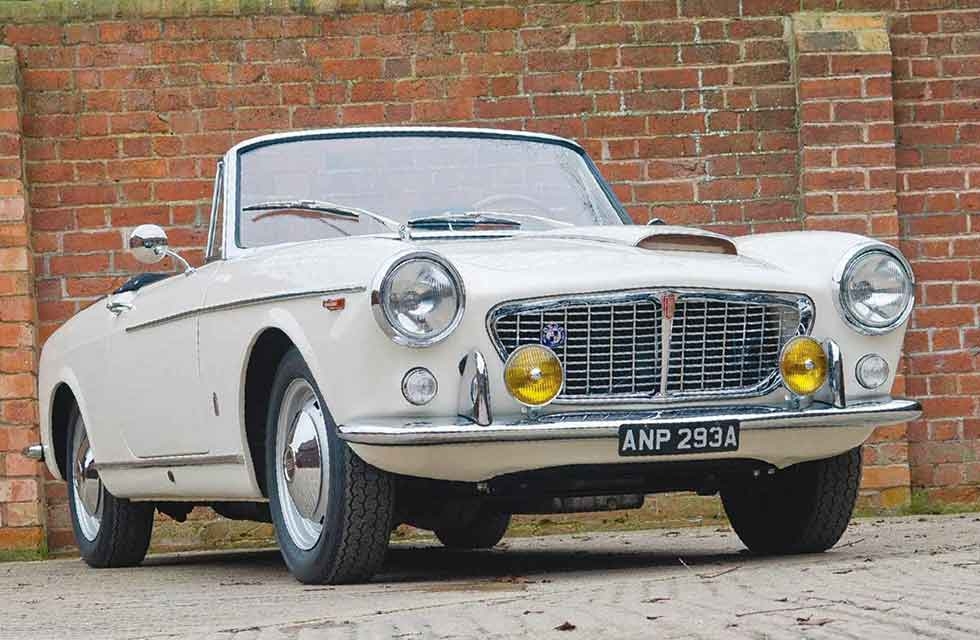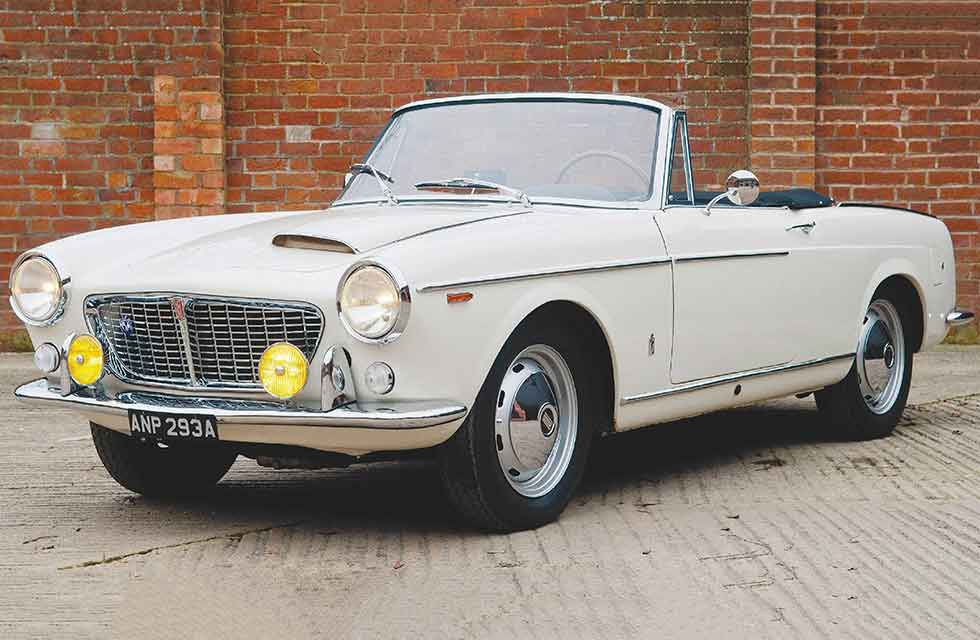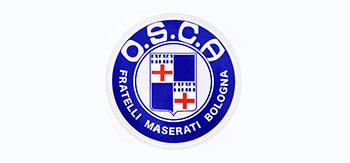
A collaborative effort between three giants of the Italian automotive scene, this car encapsulates the design flair perfected by that country in the 1950s and 1960s. It also makes a delightful two-seat tourer in the 21st century if you have an eye for beauty and a desire for something unusual. Words: Simon Goldsworthy. Pictures: Simon Cooke.
Fiat-Osca 1600 – rare Pininfarina Roadster
Very rare cabriolet with input from Fiat, Pinin Farina – and the Maserati brothers.
Something nice for the weekend, sir?
We like to bring you a mixture of familiar classics and exotic rarities on Classics, and this car certainly falls into the latter category. It is a Fiat as the badges make clear, but it was designed and built by coachbuilder Pinin Farina and the engine was developed by the Maserati brothers. And we do mean the Maserati brothers from Italy, not Bill and Joe Maserati from Peckham!

The boxout on next page explains more about the Maserati connection, but for now we can describe it as a 1963 Fiat-OSCA 1600 S Pininfarina Cabriolet. The car belongs to Andy Lerry, who bought it in 2013. He saw it at an auction, which he had gone to just to sniff around because, as Andy admits, he is always on the lookout for interesting cars.
‘It was a runner and looked sort of OK,’ he relates. ‘There was a lot of interest in it, but it wouldn’t run properly. That was because it has a mechanical throttle linkage and somebody, presumably at the auction, had put a big foot against this linkage and bent it. The result was that you couldn’t really rev it up, and so the engine sounded like it was on its last legs.’
“It does look nicer as slightly off white, which contrasts well with the various trim colours in a cabin that is so typical of Italian design of the era”
Not that this meant Andy got it for a song. In fact, by the time the finger waggling was over, he had committed to pay £16,300 for the privilege of taking it home. That was a fair bit of cash for a car with an engine on its last legs, but Andy didn’t panic – instead he had a careful look, figured out what the problem was, bent the linkage back and to everybody’s amazement drove out of the place and home.
His initial thoughts had been that the Fiat was an interesting car he could spruce up a bit and maybe sell on for a decent profit. However, as so often happens, a quick spruce up soon turned into a full restoration. And although Andy had sorted the linkage and driven the car home, the OSCA engine really did turn out to be rather sick.
Sadly, it took two attempts to get the DOHC unit rebuilt properly. First a local company had a go, but their bill was suspiciously cheap and within 100km the engine had started knocking. So Andy had to take it back out, send it to Connaught Racing Engines in Kent and paid about four times as much, but it was worth every penny because he says they did a super job.
We are perhaps getting a little ahead of ourselves here though, because in the meantime Andy had completely stripped the body and taken it back to bare metal. The bodywork and underside were actually structurally perfect with only a few very minor blemishes, and it didn’t require any welding. Andy attributes this to the car having been kept in the South of France and Italy for many years in its early days – it didn’t come with a lot of history, but he has been able to pick up the story from 1992, at which point it was owned in France. It didn’t come to the UK, to Scotland in fact, until 2007.
The preparation and repaint was undertaken by a local company, Kustom 101 in Tewkesbury, Gloucestershire, who did a superb job. The colour of the Fiat when Andy got it was its original bright white. The metal section of the dashboard was also in body colour, but had been repainted at some time in a very slightly creamier shade of white which Andy thought looked really good. It was decided not to remove the dash during the restoration and leave the creamy white finish as it was, so when it came to repainting the body, a match for this was used.
It does in Andy’s opinion look nicer as slightly off white, which contrasts well with the various trim colours in a cabin that is so typical of Italian design of the era. It actually looks very Maserati, which was part of the initial appeal for Andy. ‘I’ve had a 1966 Maserati Sebring for 18 years and I love that car,’ he explains, ‘but it is now up for sale (see www.countyclassics. net). However, because of the OSCA connection, this Fiat is welcomed at Maserati club rallies so I don’t have to leave the club scene entirely.’
The interior of this car looks immaculate. Andy was helped in this regard by the fact that despite a production run of just 2275 cars and only around a couple of hundred of this exact model, there is a specialist for them. Just the one, and he is in Holland so parts can get expensive by the time they have been shipped to the UK, but at least stuff is available.
‘I was quite lucky because the guy in Holland does a carpet set ready to fit, and also seat covers,’ says Andy. ‘They are vinyl rather than leather, but very good quality, so I had those sent over, along with a repro rubber boot mat. A local trimmer restored the door cards and rebuilt the seats with new foam and the new covers, and we put Dynamat sound deadening everywhere before fitting the trim. The dash top is immaculate and had already been done by the time I got it, as was the soft top. The car also came with a rare works hardtop in good but not restored condition. I have not fitted it to the car yet as there are some catches missing.’
The brightwork was all rechromed by S&T Plating in Yate, and that really helps the car to sparkle. Of course, once you get a car in fresh paint and fit new chrome, there is a temptation to try and bring everything else up to the same level. Andy was going to replace the back lights because they looked a bit dull in comparison, but when he found out they are the same units as found on a Ferrari 250 California, he quickly decided to clean up the ones he had instead. Fortunately, they came up a treat.
So, what is it like on the road? After all, the mechanical specification with a DOHC engine and four wheel disc brakes is pretty advanced compared to your typical small British sports car of the same era.
‘It has a nice solid feel to it,’ says Andy. ‘The brakes are good, but perhaps not as good as you might expect from all-round discs. The brake pedal is surprisingly long even though everything is in top condition, and because there is no servo assistance it does feel a little dull. It stops OK, but you have to stand on it quite hard.
‘The engine is a little bit rough from cold, but once warmed up it is an absolute delight. They did do a five-speed gearbox on some of the other models, but I think it was a mistake to put a four-speeder in these as it is a little low-geared for cruising. Having said that, I didn’t rebuild the diff initially and when I put it back on the road that turned out to be noisy. I managed to find a good secondhand replacement in Italy, and that happened to have taller gearing which has made it much nicer to drive.’
That rather curious system of bars across the top of the bulkhead you can see in the underbonnet picture is actually the steering linkage. It is very unusual to have this situated so high up and with such a long drop arm, but Andy says it steers and drives really well, even if it is not an out-and-out sports car, but more of a tourer.
Not that Andy has done many miles in it yet, probably not even 500 miles a year. ‘That is because I have too many cars and not enough time to drive them all,’ he laughs. ‘I’ve got a three-car garage and a four-car garage at home. I always said I’d like to have three cars of my own and keep four for selling as a kind of hobby business, but now I have seven of my own and I’ve rented a massive barn up the road, which is dangerous because I can get another 20 cars in that!’
However, Andy does have a plan: he wants to downsize his collection so he can spend more time driving the cars that remain. ‘You can’t be everywhere and do everything,’ he explains. ‘I’m a bit famous for jumping into projects with both feet, but I am getting wiser as I get older. I’ve realised now that I don’t have as much time as I think I have to play with cars. In my mind I may be constantly cruising up and down the Amalfi coast in the Fiat, but in reality it spends most of its time locked up in the garage. Fortunately, I do also get a lot of pleasure from simply going out to the garage and looking at the car when I haven’t seen it for a while. So while I may continue to buy interesting cars, I am done with big restorations. I’m currently finishing off a 1937 Buick straight eight, and as soon as that is done, I plan to kick the cars out of the garage and trick it out nicely as a man cave instead of a workshop.’
So what happened to his initial plan for the Fiat of sprucing it up and selling it on for a profit – is that still on the cards? ‘I paid £16,300 for it in 2013 and I’ve since spent £35,000 on the restoration,’ he reveals. ‘It is probably just about worth £50,000 on a good day, but anything this rare is very hard to value. There was one sold recently that was advertised at £67,000. It was a beautiful car and I don’t know what it sold for, but that gives you an idea of where it could go. You will also see stuff that looks somewhat handy from about £25,000 though.
‘Not that this is relevant any longer, because out of the seven cars I currently own, I have decided that my downsizing plan will see me keeping just two – this Fiat and the 1937 Buick.’
OSCA AND THE MASERATI CONNECTION
The Fiat 1200 Cabriolet was launched in 1959 with an attractive two-seater body penned by Pinin Farina. There was also a high-performance derivative, the 1500 Cabriolet, powered by a 1491cc twin-cam OSCA engine and twin Weber carburettors.
OSCA (Officine Specializzate Costruzione Automobili — Fratelli Maserati S.p.A.) was a company set up in 1947 by the brothers Bindo, Ettore and Ernesto Maserati. Along with another brother, Alfieri, they had founded the Maserati Car Company in 1914, but sold it to the Orsi family in 1937. Alfieri had died in 1932, but the other Maserati brothers continued to be involved with the company for a further ten years despite the company being relocated from their native Bologna to Modena in 1940. Then, with their contractual obligations completed, they returned to Bologna to set up OSCA.
The Maserati brothers’ aim with OSCA was to build race cars to compete in the 1100cc class, for which they built their own engines based around a Fiat block. This grew to 1342cc in 1949, gained a DOHC head in 1950, and grew once again to 1453cc in 1953. A new twin-spark DOHC engine with a capacity of 1491cc was built for 1955, and it was a version of this engine that appeared in the Fiat 1500 Cabriolet of 1959.
In 1960 the name was changed slightly to the Fiat 1500 S Cabriolet with disc brakes all round, while in 1962 that engine was bored out to give 1568cc to create the 1600 S. The main distinguishing mark of the 1600 S was a rather odd asymmetric air intake on the bonnet instead of the previous dummy scoop, a feature which lasted until a mild facelift in 1963 saw the engine lowered in the frame and a flat bonnet fitted. It was effectively replaced by the Fiat 124 Spider from 1966.






